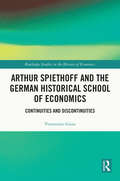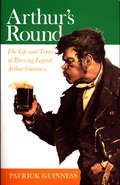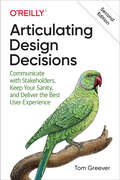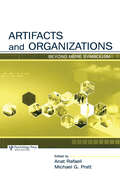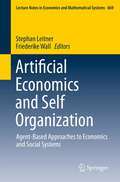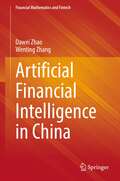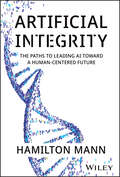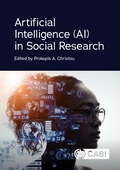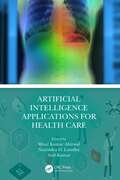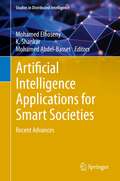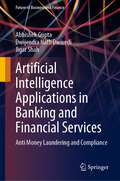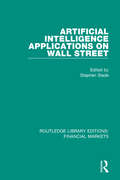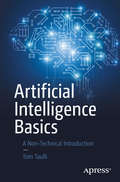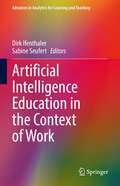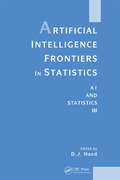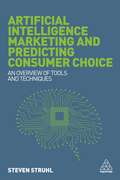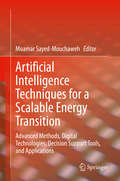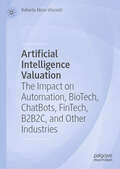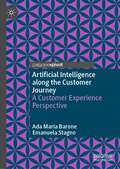- Table View
- List View
ArthroCare
by Michael J. RobertsA young company in the medical devices area, ArthroCare, has been public for six months, and its stock--after initially performing very well--is now dropping. At the same time, the company is confronted with several tactical decisions that could impact near-term earnings and thus potentially hurt the stock price.
Arthur Andersen LLP
by Jacob Cohen David F. HawkinsThis case highlights the history of Arthur Andersen and the collapse of the firm following the Enron Corp. audit and the Department of Justice obstruction of justice conviction.
Arthur Spiethoff and the German Historical School of Economics: Continuities and Discontinuities (Routledge Studies in the History of Economics)
by Vitantonio GioiaArthur Spiethoff (1873–1957), an economist of the German Historical School of Economics, is best known for his theory of the business cycle. Despite Spiethoff calling for a unified reading of his work, his epistemological thinking has received less attention. This book addresses that gap by analysing Spiethoff’s theory of the business cycle in the light of his epistemological views. Putting Spiethoff’s work in context, the book also investigates the most significant features of the evolution of the “research programme” of the German Historical School of Economics, with particular reference to the relationships between Schmoller, Sombart, Weber and Spiethoff. In addition, Spiethoff’s work is compared with some of the scientific orientations of the current debates: on the epistemological side, the book examines the relationship between Spiethoff’s views and some contemporary thinking on scientific realism, as well as methodological pluralism in social sciences. And, more broadly, it emphasises the analytical relevance of the historical approach in explaining the economic imbalances of contemporary capitalism, questioning the idea, widespread in the neoclassical approach, that taking historical specificities into account makes it hard to achieve a theoretically effective attitude. This book is a significant addition to the literature on the German Historical School of Economics and the history of economic thought, business cycle theory and macroeconomics more broadly.
Arthur's Round: The Life and Times of Brewing Legend Arthur Guinness
by Patrick GuinnessIreland's best-known Irishman, his name and signature in every household and village in Ireland, and many abroad, is also the least known. Part of Dublin life for over two centuries, both family and brewery have passed into legend, but their origins have been obscured. Here, in the round, these origins are explored and the story of the man and his background told for the first time. Various sources are examined and myths about Arthur laid to rest, many of which were allowed to continue by his descendants. This narrative traces the family's origins in Ulster, Gaelic and Protestant-Irish tenant-farmers from humble backgrounds on both sides, when Arthur's father Richard appears as a household agent in Celbridge, Co. Kildare, in 1722 to work for Arthur Price, the Protestant Dean of Kildare. In 1755 Arthur takes on a brewery in Leixlip and joins the Kildare Friendly Brothers dining club in 1758, marrying and moving to St James's Gate in 1759/60 where the business developed. By 1781 he is a patriarch and member of liberal 'patriot' political groups, diversifying his assets to preserve his wealth in unsettled times. Of a generation with Edmund Burke and Richard Brinsley Sheridan, this wily businessman built an empire that endured and expanded. Family and social history combine with an account of the brewing process and descriptions of economic and political backgrounds in a rapidly developing Ireland, giving a rich weave to this tapestry. Visual sources include maps, rare original documents, prints, and photographs of associated houses and places, people, and artifacts. The result is a fascinating contextual portrait of an enigmatic figure, the founding father of one of Ireland's most powerful dynasties.
Articles of Agreement of the International Monetary Fund
by International Monetary FundA report from the International Monetary Fund.
Articulate Your Purposes: Identifying the Motivations behind the Drive to Lead Adaptive Change
by Alexander Grashow Marty Linsky Ronald HeifetzTaking on adaptive challenges isn't easy. The only reason you would want to do this kind of work is to serve purposes that matter to you deeply. Identifying your higher purposes--figuring out what is so important to you that you would be willing to put yourself in peril--is a key element in the process of understanding yourself on a deep level. Understanding your purposes will help you orient yourself and your decisions within a larger context, while also helping you allocate your time and perform day-to-day tasks. This chapter describes how to clarify your priorities among various orienting purposes and test your assumptions. This chapter was originally published as chatper 18 of "The Practice of Adaptive Leadership: Tools and Tactics for Changing Your Organization and the World."
Articulating Design Decisions: Communicate With Stakeholders, Keep Your Sanity, And Deliver The Best User Experience
by Tom GreeverTalking to people about your designs might seem like a basic skill, but it can be difficult to do well. In many cases, how you communicate with stakeholders, clients, and other nondesigners may be more important than the designs themselves. Because if you canâ??t get their support, your work will never see the light of dayâ??no matter how good it is.This practical guide focuses on principles, tactics, and actionable methods for presenting your designs. Whether you design apps, websites, or products, youâ??ll learn how to get support from people who have influence over the project with the goal of creating the best user experience.Walk through the process of preparing and presenting your designsUnderstand stakeholder perspectives and learn how to empathize with themCultivate both implicit and explicit listening skillsLearn tactics and strategies for expressing the most effective response to feedbackCreate the right documentation for your decisions to avoid repeated conversationsLearn why following through is just as important as the meeting itself
Artifacts Versus Nature Body: A Wealth-Additive Scheme of Enterprise, Economics, and Nature Managing
by Masayuki MatsuiThis book proposes a wealth-additive scheme of managing and maximizing (win–win and sharing) the marginal value (eco-entropy) of artifacts by humanizing the artifacts’ enterprise and their economics with nature. This type of clockwork would be achieved on a base of the science of nature versus artifacts and the body of science in my Springer books since 2008. My books are advancing factory science, economics, and the science of artifacts and play their role in the sandwich theory and its pair-map microcosm of the 3D-type, toward the development of body science. Then, the wealth-additive goal of the “body” is not only similar to the marginal profit, GDP, and value in economics, but also means the marginal diversity (eco-entropy) and its wealth of economics versus reliability (sustainability) in the body of the world. The modern world, for example, is faced with deadlocked negotiations over the Sustainable Development Goals (SDGs) bodies at the United Nations. Thus, the forthcoming world of SDGs would be much better and more constructive at transforming traditional bodies of the 3M&I class (human, material, money, and information) as some nano (gene/therblig)-transformation toward eco-entropy(marginal value/diversity) on earth. This semi-visible world is traditionally limited to a molecular size and is too rough at the practical rig-level. Thus, any unsolved and invisible contradictions left behind on earth are subject to SDGs in the practical world. This approach proposes a visible method that could find and solve these contradictions (angles) by transforming the artifact's body, consisting of the 3M&I gene. The pair-map microcosm and its Matsui's M-equation have been designed mainly based on nature and science books on artifacts (in 2016 and 2019). Following these visible methods, our well-being subject might be able to make a breakthrough or make such unsolved contradictions or stalemates subside as any SDGs society of individuals in the near future.Finally, the book will explore and construct a new academic discipline involving 3M&I body science versus cybernetics. And, the study introduces validation cases of convenience stores, self-driving cars, and robotization (individualization) of artificial objects as the realization of the supply–demand system and the ideal form of artificial and natural bodies. Based on this perspective, the dialogue is conducted according to a creative structure of six parts, twelve chapters, and two appendices.
Artifacts and Organizations: Beyond Mere Symbolism (Organization and Management Series)
by Anat Rafaeli Michael G. PrattArtifacts in organizations are ubiquitous but often overlooked. The chapters in this book illustrate that artifacts are everywhere in organizational life. They prevail in how offices are decorated, language is used, business cards are designed, and office cartoons are displayed. In addition, artifacts can be seen in the name of an organization and its employees, products, buildings, processes, and contracts, and they represent people, organizations, and professions.Artifacts and Organizations suggests that artifacts are neither superficial nor pertinent only to organizational culture. They are relevant to a rich and diverse set of organizational processes within and across multiple levels of analysis. Artifacts are shown to be integral to identity, sense-giving and sense-making processes, interpretation and negotiation, legitimacy, and branding. The book seeks to communicate that artifacts are often much more than what is currently recognized in organizational research. The four sections of this edited volume address various aspects of what is known about and known through artifacts. Together, the full set of chapters challenge the field to move beyond a narrow conceptualization and understanding of artifacts in organizations.This book leads students to embrace the full complexity and richness of artifacts. In addition, the text seeks to inspire those who focus on artifacts as symbols to delve deeper into the complexities of artifacts-in-use, for individuals, organizations, and institutions.
Artificial Economics and Self Organization: Agent-Based Approaches to Economics and Social Systems (Lecture Notes in Economics and Mathematical Systems #669)
by Stephan Leitner Friederike WallThis volume presents recent advances in the dynamic field of Artificial Economics and its various applications. Artificial Economics provides a structured approach to model and investigate economic and social systems. In particular, this approach is based on the use of agent-based simulations and further computational techniques. The main aim is to analyze the outcomes at the overall systems' level as results from the agents' behavior at the micro-level. These emergent characteristics of complex economic and social systems can neither be foreseen nor are they intended. The emergence rather makes these systems function. Artificial Economics especially facilitates the investigation of this emergent systems' behavior.
Artificial Financial Intelligence in China (Financial Mathematics and Fintech)
by Wenting Zhang Dawei ZhaoThis book starts from the application scenarios of artificial financial intelligence regulation, commercial banking, wealth management and payments, etc., and makes a detailed study of the main scenarios of the application of China's artificial intelligence in the financial field, and also analysis specific application cases of China.With the popularization of smart phones and the rapid development of e-commerce, mobile payment, big data and other technologies are in the ascendant in China in recent years. In particular, artificial intelligence technologies in the form of facial, speech and semantic recognition are showing preliminary advantages in the field of FinTech, and the future era of Intelligent Finance has quietly come. The Chinese government has clearly put forward "China should rely on a robust cycle of domestic demand and innovation as the main driver of the economy while maintaining foreign markets and investors as a second engine of growth", science and technology innovation is the basic motivation of economic and social cycle, to implement the " dual circulation strategy ", it is necessary to understand the key role of scientific and technological innovation in financial innovation services, and improve financial services must be driven by science and technology. There is a natural relationship between artificial intelligence and financial services, because financial services are credit and information intermediaries, and data is the most critical for finance, while artificial intelligence has a super ability in dealing with complex data. At present, many Chinese Banks have applied artificial intelligence to their daily operations and management, such as accurate customer identification, enhanced process tracking, intelligent marketing, and product process transformation, so as to simplify financial service processes and shorten service cycles. In General, this book both pays attention to practical application and theoretical, which is a useful reference book in theoretical research and practical work, and also helps readers to understand the application of intelligent finance in China.
Artificial Integrity: The Paths to Leading AI Toward a Human-Centered Future
by Hamilton MannNavigating the transitions to the future of AI—Integrity over Intelligence Envision a world where artificial intelligence can deliver integrity-led outcomes seamlessly, adapting to diverse cultural context, value models, and situational nuances, countering subconscious biases, all while operating in an advanced human-centered manner. This is the promise of Artificial Integrity. In Artificial Integrity, digital strategist, technologist, doctoral researcher, acclaimed management thinker, and seasoned business executive Hamilton Mann emphasizes that the challenge of AI is in ensuring systems that exhibit integrity-led capabilities over the pursuit of mere general or super intelligence. Mann tackles the inadequacies of traditional ethical frameworks in handling the complexities of new AI technologies to make them trustworthy and reliable as they profoundly impact human lives. Introducing the transformative concept of “artificial integrity,” Mann proposes a paradigm shift, defining a “code of design” to ensure AI systems align with, amplify, and sustain human values and societal norms, maximizing integrity-led AI outcomes. Artificial Integrity discusses practical insights into driving a future where AI enhances, without replacing, human capabilities while being inclusive and reflective of diverse human experiences, emphasizing human agency. The book offers: Guiding posts and step-by-step solutions for designing, implementing and continuously aligning AI development to responsibly advance human and artificial co-intelligence Strategies and actionable advice for integrating AI into business and societal structures Practical paths toward managing the transition to the future of AI for human productivity and decision-making while maintaining sustainable trustworthiness Artificial Integrity is essential for anyone involved in AI development, from executives, business leaders, and managers to entrepreneurs, tech enthusiasts and policymakers. It's also perfect for laypeople interested in how AI intersects with society. Dive into this compelling and thought provoking read to ensure you are prepared for the challenges and opportunities that lie ahead in a human-centered AI-driven future.
Artificial Intelligence (AI) in Social Research
The field of social research is characterized by its broad scope and interdisciplinary nature, encompassing the examination of human behaviour, societies, and various facets of social existence; however, it is influenced by numerous factors, including technological advancements. It is therefore no surprise that Artificial Intelligence (AI) has rapidly become a driving force, bringing about substantial transformations within the field. The use of AI-assisted tools and programmes for the collection, analysis, and interpretation of both quantitative and qualitative data is increasing at a remarkable pace. The implications of utilizing these applications are significant and noteworthy. While these technologies present numerous opportunities, it is important to acknowledge the accompanying dilemmas and risks associated with this form of technological advancement. With a focus on AI's research implications, this book explores various considerations and examples across different disciplines of social research. It highlights the considerable promise AI holds for revolutionizing the discipline while also guiding readers in contemplating the potential drawbacks and various concerns. By doing so, researchers can optimize the capabilities of AI and promote its responsible, reliable, and beneficial application in enhancing and advancing social research.
Artificial Intelligence Applications for Health Care
by Anil Kumar Mitul Kumar Ahirwal Narendra D. LondheThis book takes an interdisciplinary approach by covering topics on health care and artificial intelligence. Data sets related to biomedical signals (ECG, EEG, EMG) and images (X-rays, MRI, CT) are explored, analyzed, and processed through different computation intelligence methods. Applications of computational intelligence techniques like artificial and deep neural networks, swarm optimization, expert systems, decision support systems, clustering, and classification techniques on medial datasets are explained. Survey of medical signals, medial images, and computation intelligence methods are also provided in this book. Key Features Covers computational Intelligence techniques like artificial neural networks, deep neural networks, and optimization algorithms for Healthcare systems Provides easy understanding for concepts like signal and image filtering techniques Includes discussion over data preprocessing and classification problems Details studies with medical signal (ECG, EEG, EMG) and image (X-ray, FMRI, CT) datasets Describes evolution parameters such as accuracy, precision, and recall etc. This book is aimed at researchers and graduate students in medical signal and image processing, machine and deep learning, and healthcare technologies.
Artificial Intelligence Applications for Smart Societies: Recent Advances (Studies in Distributed Intelligence)
by Mohamed Elhoseny K. Shankar Mohamed Abdel-BassetThis volume discusses recent advances in Artificial Intelligence (AI) applications in smart, internet-connected societies, highlighting three key focus areas. The first focus is on intelligent sensing applications. This section details the integration of Wireless Sensing Networks (WSN) and the use of intelligent platforms for WSN applications in urban infrastructures, and discusses AI techniques on hardware and software systems such as machine learning, pattern recognition, expert systems, neural networks, genetic algorithms, and intelligent control in transportation and communications systems. The second focus is on AI-based Internet of Things (IoT) systems, which addresses applications in traffic management, medical health, smart homes and energy. Readers will also learn about how AI can extract useful information from Big Data in IoT systems. The third focus is on crowdsourcing (CS) and computing for smart cities. this section discusses how CS via GPS devices, GIS tools, traffic cameras, smart cards, smart phones and road deceleration devices enables citizens to collect and share data to make cities smart, and how these data can be applied to address urban issues including pollution, traffic congestion, public safety and increased energy consumption. This book will of interest to academics, researchers and students studying AI, cloud computing, IoT and crowdsourcing in urban applications.
Artificial Intelligence Applications in Banking and Financial Services: Anti Money Laundering and Compliance (Future of Business and Finance)
by Abhishek Gupta Dwijendra Nath Dwivedi Jigar ShahThis book discusses all aspects of money laundering, starting from traditional approach to financial crimes to artificial intelligence-enabled solutions. It also discusses the regulators approach to curb financial crimes and how syndication among financial institutions can create a robust ecosystem for monitoring and managing financial crimes. It opens with an introduction to financial crimes for a financial institution, the context of financial crimes, and its various participants. Various types of money laundering, terrorist financing, and dealing with watch list entities are also part of the discussion. Through its twelve chapters, the book provides an overview of ways in which financial institutions deal with financial crimes; various IT solutions for monitoring and managing financial crimes; data organization and governance in the financial crimes context; machine learning and artificial intelligence (AI) in financial crimes; customer-level transaction monitoring system; machine learning-driven alert optimization; AML investigation; bias and ethical pitfalls in machine learning; and enterprise-level AI-driven Financial Crime Investigation (FCI) unit. There is also an Appendix which contains a detailed review of various data sciences approaches that are popular among practitioners.The book discusses each topic through real-life experiences. It also leverages the experience of Chief Compliance Officers of some large organizations to showcase real challenges that heads of large organizations face while dealing with this sensitive topic. It thus delivers a hands-on guide for setting up, managing, and transforming into a best-in-class financial crimes management unit. It is thus an invaluable resource for researchers, students, corporates, and industry watchers alike.
Artificial Intelligence Applications on Wall Street (Routledge Library Editions: Financial Markets #16)
by Stephen SladeOriginally published in 1996 as a special issue journal, Artificial Intelligence Applications on Wall Street, presents a series of articles derived from papers at the Third International Conference on Artificial Intelligence Applications on Wall Street. The volume addresses how Artificial Intelligence can be used to address the variety of issues in that arise in the world of investments, such as synthetic instruments, forecasting and surveillance. It examines the potential problems surrounding economic assumption of rationality in a global market, and how artificial intelligence can push the bounds of rationality.
Artificial Intelligence Basics: A Non-Technical Introduction
by Tom TaulliArtificial intelligence touches nearly every part of your day. While you may initially assume that technology such as smart speakers and digital assistants are the extent of it, AI has in fact rapidly become a general-purpose technology, reverberating across industries including transportation, healthcare, financial services, and many more. In our modern era, an understanding of AI and its possibilities for your organization is essential for growth and success.Artificial Intelligence Basics has arrived to equip you with a fundamental, timely grasp of AI and its impact. Author Tom Taulli provides an engaging, non-technical introduction to important concepts such as machine learning, deep learning, natural language processing (NLP), robotics, and more. In addition to guiding you through real-world case studies and practical implementation steps, Taulli uses his expertise to expand on the bigger questions that surround AI. These include societal trends, ethics, and future impact AI will have on world governments, company structures, and daily life. Google, Amazon, Facebook, and similar tech giants are far from the only organizations on which artificial intelligence has had—and will continue to have—an incredibly significant result. AI is the present and the future of your business as well as your home life. Strengthening your prowess on the subject will prove invaluable to your preparation for the future of tech, and Artificial Intelligence Basics is the indispensable guide that you’ve been seeking. What You Will LearnStudy the core principles for AI approaches such as machine learning, deep learning, and NLP (Natural Language Processing)Discover the best practices to successfully implement AI by examining case studies including Uber, Facebook, Waymo, UiPath, and Stitch FixUnderstand how AI capabilities for robots can improve businessDeploy chatbots and Robotic Processing Automation (RPA) to save costs and improve customer serviceAvoid costly gotchasRecognize ethical concerns and other risk factors of using artificial intelligenceExamine the secular trends and how they may impact your business Who This Book Is For Readers without a technical background, such as managers, looking to understand AI to evaluate solutions.
Artificial Intelligence Education in the Context of Work (Advances in Analytics for Learning and Teaching)
by Dirk Ifenthaler Sabine SeufertThis edited volume remedies existing deficiencies in the literature on artificial intelligence and education in the context of work. The topics addressed by this book are: • Supporting formal and informal learning through AI• Human-machine collaboration for learning at the workplace, including the potential of human-AI interaction in professional and vocational education contexts, design, use, and evaluation of human-AI hybrid systems for learning• Intelligent and Interactive Technologies for Learning, including natural language processing and speech technologies; data mining and machine learning; knowledge representation and reasoning; semantic web technologies, chat bot-mediated learning, and conversational learning, • AI-enabled applications for skills management and personalized learning, such as AI-enabled coaching, personalized skill management, and intelligent tutoring systems. • Case studies for the implementation and use of AI-enabled learning and performance solutions, such as personal learning experience platforms, and automated performance feedback.
Artificial Intelligence For Dummies
by John Paul Mueller Stephanie Diamond Luca MassaronDive into the intelligence that powers artificial intelligence Artificial intelligence is swiftly moving from a sci-fi future to a modern reality. This edition of Artificial Intelligence For Dummies keeps pace with the lighting-fast expansion of AI tools that are overhauling every corner of reality. This book demystifies how artificial intelligence systems operate, giving you a look at the inner workings of AI and explaining the important role of data in creating intelligence. You'll get a primer on using AI in everyday life, and you'll also get a glimpse into possible AI-driven futures. What's next for humanity in the age of AI? How will your job and your life change as AI continue to evolve? How can you take advantage of AI today to make your live easier? This jargon-free Dummies guide answers all your most pressing questions about the world of artificial intelligence. Learn the basics of AI hardware and software, and how intelligence is created from code Get up to date with the latest AI trends and disruptions across industries Wrap your mind around what the AI revolution means for humanity, and for you Discover tips on using generative AI ethically and effectively Artificial Intelligence For Dummies is the ideal starting point for anyone seeking a deeper technological understanding of how artificial intelligence works and what promise it holds for the future.
Artificial Intelligence Frontiers in Statistics: Al and Statistics III
by David J. HandThis book presents a summary of recent work on the interface between artificial intelligence and statistics. It does this through a series of papers by different authors working in different areas of this interface. These papers are a selected and referenced subset of papers presented at the 3rd Interntional Workshop on Artificial Intelligence and Statistics, Florida, January 1991.
Artificial Intelligence Marketing and Predicting Consumer Choice: An Overview of Tools and Techniques
by Dr Steven StruhlThe ability to predict consumer choice is a fundamental aspect to success for any business. In the context of artificial intelligence marketing, there are a wide array of predictive analytic techniques available to achieve this purpose, each with its own unique advantages and disadvantages. Artificial Intelligence Marketing and Predicting Consumer Choice serves to integrate these widely disparate approaches, and show the strengths, weaknesses, and best applications of each. It provides a bridge between the person who must apply or learn these problem-solving methods and the community of experts who do the actual analysis. It is also a practical and accessible guide to the many remarkable advances that have been recently made in this fascinating field.
Artificial Intelligence Techniques for a Scalable Energy Transition: Advanced Methods, Digital Technologies, Decision Support Tools, and Applications
by Moamar Sayed-MouchawehThis book presents research in artificial techniques using intelligence for energy transition, outlining several applications including production systems, energy production, energy distribution, energy management, renewable energy production, cyber security, industry 4.0 and internet of things etc. The book goes beyond standard application by placing a specific focus on the use of AI techniques to address the challenges related to the different applications and topics of energy transition. The contributions are classified according to the market and actor interactions (service providers, manufacturers, customers, integrators, utilities etc.), to the SG architecture model (physical layer, infrastructure layer, and business layer), to the digital twin of SG (business model, operational model, fault/transient model, and asset model), and to the application domain (demand side management, load monitoring, micro grids, energy consulting (residents, utilities), energy saving, dynamic pricing revenue management and smart meters, etc.).
Artificial Intelligence Valuation: The Impact on Automation, BioTech, ChatBots, FinTech, B2B2C, and Other Industries
by Roberto Moro-ViscontiThe book discusses the main valuation methodologies of artificial intelligence (AI). Company valuation goes hand in hand with estimating intangible assets like AI, which are linked to higher risk and lower collateral value. Their accounting is controversial, and the most widely used valuation approaches are based on market, income, or cost-related metrics.The volume discusses in detail the valuation approaches such as the discounted cash flows (remembering that “cash is king”) or the empirical market multipliers and comparables. The approaches are complemented by several models, including advanced business planning that incorporates machine learning, digital scalability networks, or validating blockchains. The book, with a tailor-made theoretical background backed by empirical cases, shows how to evaluate AI products, such as chatbots or virtual assistants, for AI established producers, startups, or traditional “brick-and-mortar” AI users. The comprehensive set of techniques and methodologies will interest researchers, students, and practitioners in corporate finance, intellectual property valuation, and financial technology.
Artificial Intelligence along the Customer Journey: A Customer Experience Perspective
by Ada Maria Barone Emanuela StagnoThe development of several AI solutions has revolutionized the way in which consumers behave. Serving as a guide to the role that AI plays on different aspects of consumers’ life, this book provides a comprehensive understanding of the main artificial intelligence (AI) solutions available in the market. In particular, the authors adopt a customer experience approach to investigate how different AI technologies play a role at different stages of the customer journey (e.g., from pre-purchase to post-purchase decisions). Covering a range of technologies, such as augmented reality, voice assistants, chatbots and robots, readers will be able to learn which strategies and AI solutions are more effective at different stages of the customer journey.

